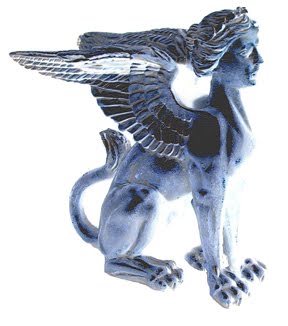"Take that statue away. It is not for me to erect statues to myself."
Napoleon, to Pierre Fontaine.
There's only one statue in the neighborhood where I live (and it isn't very heroic.) It commemorates Harry Culver, the founder of Culver City.
Napoleon, to Pierre Fontaine.
There's only one statue in the neighborhood where I live (and it isn't very heroic.) It commemorates Harry Culver, the founder of Culver City.
Nearby is "The Lion's Fountain," meant to reference two MGM studio lions–Leo the Lion, and the Cowardly Lion from The Wizard of Oz (which was filmed in Culver City). The only interest this stiff, ungainly piece of public art possesses (left) is a strange resemblance to Moses in the Fontana dell'Acqua Felice in Rome (right).
Both gain in this comparison, for "The Lion" appears to be preparing for crucifixion, while Moses acquires a swaggering insouciance undetectable in conventional depictions of the prophet.
With the dearth of statues, hence the lack of their inevitable auxiliary, pigeons. Seeking this combination of statues and pigeons, I look through "The Statues of Paris: An Open-Air Pantheon, The History of Statues to Great Men," an impressive book with 588 photographs, published in 1989 by Vendome Press. Not a single pigeon to be found. Surely that can't be because there are no pigeons in France.
Turning to another picture book, "The Fountains of Rome," published in 1996 with photographs by Francesco Venturi, also Vendome Press, I was glad to see that a really surprising number of pigeons have crept into the photographs.
I enjoy the unintended dynamics created by the conflux of statues with the birds. It's difficult enough to decipher the vanished narratives of some of these statues, their meanings so obscure to modern eyes. Pigeons muddy the waters even further.
For instance, here an eagle seems to be used as a shield to protect a lamb from the weight of two pigeons, or from their droppings. (my photo)
But of course it's Ganymede, a shepherd, preparing to soar to heaven in the talons of the eagle.
Pigeons provide, at least, a semblance of companionship for statues. Two very large pigeons (photo, The Fountains of Rome) seem to be entertaining this maenad.
A pigeon observing what is going on below (photo, Fountains of Rome).
Pigeons also, in their uncomprehending way, provide a "Look upon my works ye mighty, and despair" sort of effect. For who is higher than Lord Nelson, solitary on the very pinnacle of fame? A pigeon. Who defaces, not with the malicious intent of a iconoclast, but with a godlike imperviousness to the strivings of mankind after glory? A pigeon.
True, statues of heroes are at risk from more than birds. The scribblings and droppings of a certain kind of human pigeon can have the same result.
Pincio Park, in Rome, has the air of a park which has seen better days–much like the reputations of hundreds of great men whose statues throng it's walks. Many of the statues are defaced, for the park is plagued with vandalism (evidently noses are broken so often that the park retains a mold of each.)
Pietro Antonio Domenico Trapassi, known as Metastasio, (1698–1782), Italian poet.
Raimondo, Count of Montecúccoli or Montecucculi (1608–1680), Italian military general and prince of the Holy Roman Empire.












